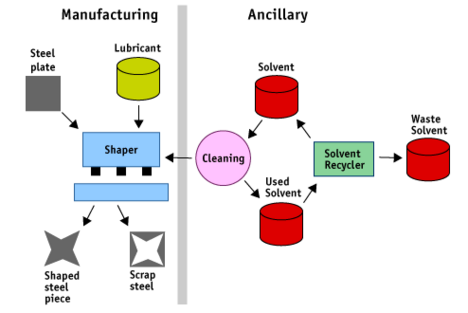How Companies Use Toxics
Toxics are used and toxic byproducts are generated in companies in two different areas: in manufacturing and in ancillary activities.
For manufacturing, a toxic material may be an input to a manufacturing process, such as a solvent used as one ingredient of the paint that a company sells, or a toxic many be created as a result of the manufacturing process, such as two chemicals mixed together to create a third chemical which is then sold by the company.
Ancillary activities are activities that go on at a company that are not directly part of the manufacturing process. For example, a company that makes metal parts might use a solvent to clean a machine between uses. The solvent is not really part of the manufacturing process, rather it is part of an ancillary activity. The picture below shows this graphically.
Toxics Use - An Example
One example of the use of toxics in manufacturing would be the creation of a silver-plated platter. A company might begin with the pre-formed base metal parts, in this case copper platters.
- First the copper parts are immersed in a sulfuric acid bath to prepare the surface of the platters to receive the silver. The sulfuric acid does not become part of the final product, so it is called otherwise used. When the sulfuric acid is discarded it would be called byproduct because it does not become part of the product.
- Next the platters are immersed in a silver plating bath. Both the copper and the silver are processed. The end result of the process is a silver-plated platter (with copper under the silver plate).
- Most of the copper and silver that is processed becomes part of the final product and is called shipped in product.
- A little of the copper and silver ends up either in the sulfuric acid bath or in the silver-plating bath and is called byproduct.
- The company may consider the equipment and materials that are use used in this process as one production unit, with a description of 'prepare and plate silver-platters' or the company may consider it two different production units, with descriptions of 'prepare parts to be plated' and 'plate parts.'
- The end result of the manufacturing process, the silver-plated platter, is called the product.
When you look at the community, company and chemical reports that show quantities of toxics, you will see the quantities reported using these same categories: processed, otherwise used, byproduct, and shipped. Other categories that you will see are manufactured and released. You will also see reports that list production units, along with a description of the process each uses and the product(s) each produces.
